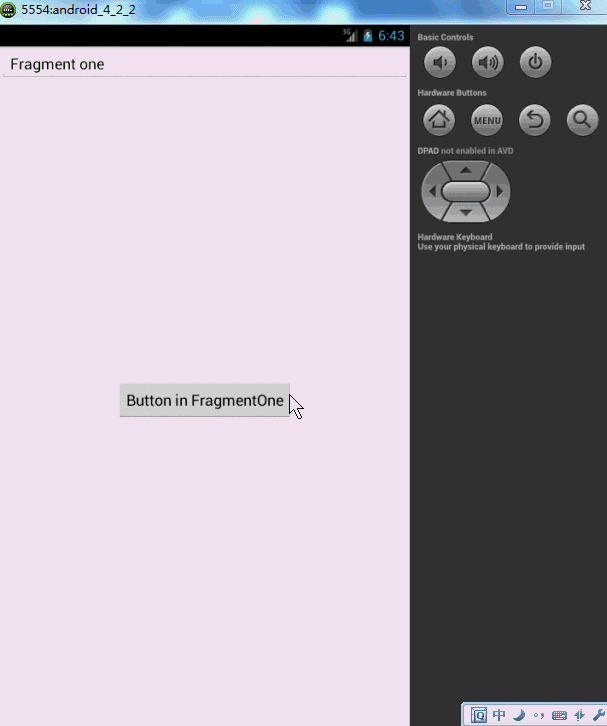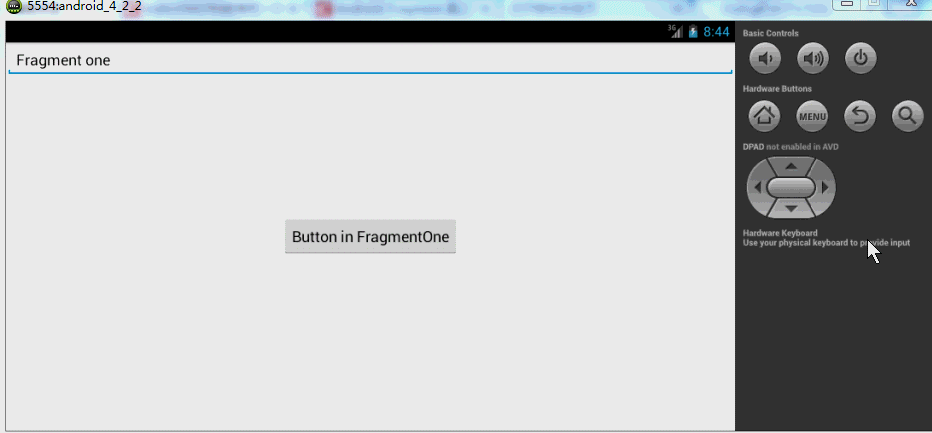- ubuntu12.04环境下使用kvm ioctl接口实现最简单的虚拟机
- Ubuntu 通过无线网络安装Ubuntu Server启动系统后连接无线网络的方法
- 在Ubuntu上搭建网桥的方法
- ubuntu 虚拟机上网方式及相关配置详解
CFSDN坚持开源创造价值,我们致力于搭建一个资源共享平台,让每一个IT人在这里找到属于你的精彩世界.
这篇CFSDN的博客文章深入浅析Android Fragment(下篇)由作者收集整理,如果你对这篇文章有兴趣,记得点赞哟.
在上篇文章给大家介绍深入浅析android fragment(上篇),包括一些基本的用法和各种api,如果还想深入学习请继续关注本篇文章.
本篇将介绍上篇提到的:如何管理fragment回退栈,fragment如何与activity交互,fragment与activity交互的最佳实践,没有视图的fragment的用处,使用fragment创建对话框,如何与actionbar,menuitem集成等~~ 。
1、管理fragment回退栈 。
类似与android系统为activity维护一个任务栈,我们也可以通过activity维护一个回退栈来保存每次fragment事务发生的变化。如果你将fragment任务添加到回退栈,当用户点击后退按钮时,将看到上一次的保存的fragment。一旦fragment完全从后退栈中弹出,用户再次点击后退键,则退出当前activity.
看这样一个效果图:

点击第一个按钮,切换到第二个界面,点击第二个按钮,切换到第三个界面,然后点击back键依次回退。这像不像初学android时的activity跳转,当然了,这里肯定不是,不然我就跪了。这里是fragment实现的,用户点击back,实际是fragment回退栈不断的弹栈.
如何添加一个fragment事务到回退栈:
fragmenttransaction.addtobackstack(string) 。
下面讲解代码:很明显一共是3个fragment和一个activity. 。
先看activity的布局文件:
|
1
2
3
4
5
6
7
8
9
10
|
<relativelayout xmlns:android=
"http://schemas.android.com/apk/res/android"
xmlns:tools=
"http://schemas.android.com/tools"
android:layout_width=
"match_parent"
android:layout_height=
"match_parent"
>
<framelayout
android:id=
"@+id/id_content"
android:layout_width=
"fill_parent"
android:layout_height=
"fill_parent"
>
</framelayout>
</relativelayout>
|
不同的fragment就在这个framelayout中显示.
mainactivity.java 。
|
1
2
3
4
5
6
7
8
9
10
11
12
13
14
15
16
17
18
19
20
|
package
com.zhy.zhy_fragments;
import
android.app.activity;
import
android.app.fragmentmanager;
import
android.app.fragmenttransaction;
import
android.os.bundle;
import
android.view.window;
public
class
mainactivity
extends
activity
{
@override
protected
void
oncreate(bundle savedinstancestate)
{
super
.oncreate(savedinstancestate);
requestwindowfeature(window.feature_no_title);
setcontentview(r.layout.activity_main);
fragmentmanager fm = getfragmentmanager();
fragmenttransaction tx = fm.begintransaction();
tx.add(r.id.id_content,
new
fragmentone(),
"one"
);
tx.commit();
}
}
|
很简单,直接将fragmentone添加到布局文件中的framelayout中,注意这里并没有调用fragmenttransaction.addtobackstack(string),因为我不喜欢在当前显示时,点击back键出现白板。而是正确的相应back键,即退出我们的activity. 。
下面是fragmentone 。
|
1
2
3
4
5
6
7
8
9
10
11
12
13
14
15
16
17
18
19
20
21
22
23
24
25
26
27
28
29
30
31
32
33
|
package
com.zhy.zhy_fragments;
import
android.app.fragment;
import
android.app.fragmentmanager;
import
android.app.fragmenttransaction;
import
android.os.bundle;
import
android.view.layoutinflater;
import
android.view.view;
import
android.view.view.onclicklistener;
import
android.view.viewgroup;
import
android.widget.button;
public
class
fragmentone
extends
fragment
implements
onclicklistener
{
private
button mbtn;
@override
public
view oncreateview(layoutinflater inflater, viewgroup container,
bundle savedinstancestate)
{
view view = inflater.inflate(r.layout.fragment_one, container,
false
);
mbtn = (button) view.findviewbyid(r.id.id_fragment_one_btn);
mbtn.setonclicklistener(
this
);
return
view;
}
@override
public
void
onclick(view v)
{
fragmenttwo ftwo =
new
fragmenttwo();
fragmentmanager fm = getfragmentmanager();
fragmenttransaction tx = fm.begintransaction();
tx.replace(r.id.id_content, ftwo,
"two"
);
tx.addtobackstack(
null
);
tx.commit();
}
}
|
我们在点击fragmentone中的按钮时,使用了replace方法,如果你看了前一篇博客,一定记得replace是remove和add的合体,并且如果不添加事务到回退栈,前一个fragment实例会被销毁。这里很明显,我们调用tx.addtobackstack(null);将当前的事务添加到了回退栈,所以fragmentone实例不会被销毁,但是视图层次依然会被销毁,即会调用ondestoryview和oncreateview,证据就是:仔细看上面的效果图,我们在跳转前在文本框输入的内容,在用户back得到第一个界面的时候不见了.
接下来fragmenttwo 。
|
1
2
3
4
5
6
7
8
9
10
11
12
13
14
15
16
17
18
19
20
21
22
23
24
25
26
27
28
29
30
31
32
33
34
35
|
package
com.zhy.zhy_fragments;
import
android.app.fragment;
import
android.app.fragmentmanager;
import
android.app.fragmenttransaction;
import
android.os.bundle;
import
android.view.layoutinflater;
import
android.view.view;
import
android.view.view.onclicklistener;
import
android.view.viewgroup;
import
android.widget.button;
public
class
fragmenttwo
extends
fragment
implements
onclicklistener
{
private
button mbtn ;
@override
public
view oncreateview(layoutinflater inflater, viewgroup container,
bundle savedinstancestate)
{
view view = inflater.inflate(r.layout.fragment_two, container,
false
);
mbtn = (button) view.findviewbyid(r.id.id_fragment_two_btn);
mbtn.setonclicklistener(
this
);
return
view ;
}
@override
public
void
onclick(view v)
{
fragmentthree fthree =
new
fragmentthree();
fragmentmanager fm = getfragmentmanager();
fragmenttransaction tx = fm.begintransaction();
tx.hide(
this
);
tx.add(r.id.id_content , fthree,
"three"
);
// tx.replace(r.id.id_content, fthree, "three");
tx.addtobackstack(
null
);
tx.commit();
}
}
|
这里点击时,我们没有使用replace,而是先隐藏了当前的fragment,然后添加了fragmentthree的实例,最后将事务添加到回退栈。这样做的目的是为了给大家提供一种方案:如果不希望视图重绘该怎么做,请再次仔细看效果图,我们在fragmenttwo的edittext填写的内容,用户back回来时,数据还在~~~ 。
最后fragmentthree就是简单的toast了:
|
1
2
3
4
5
6
7
8
9
10
11
12
13
14
15
16
17
18
19
20
21
22
23
24
25
26
27
28
|
package
com.zhy.zhy_fragments;
import
android.app.fragment;
import
android.os.bundle;
import
android.view.layoutinflater;
import
android.view.view;
import
android.view.view.onclicklistener;
import
android.view.viewgroup;
import
android.widget.button;
import
android.widget.toast;
public
class
fragmentthree
extends
fragment
implements
onclicklistener
{
private
button mbtn;
@override
public
view oncreateview(layoutinflater inflater, viewgroup container,
bundle savedinstancestate)
{
view view = inflater.inflate(r.layout.fragment_three, container,
false
);
mbtn = (button) view.findviewbyid(r.id.id_fragment_three_btn);
mbtn.setonclicklistener(
this
);
return
view;
}
@override
public
void
onclick(view v)
{
toast.maketext(getactivity(),
" i am a btn in fragment three"
,
toast.length_short).show();
}
}
|
好了,经过上面的介绍,应该已经知道fragment回退栈是怎么一回事了,以及hide,replace等各自的应用的场景。 这里极其注意一点:上面的整体代码不具有任何参考价值,纯粹为了显示回退栈,在后面讲解了fragment与activity通信以后,会重构上面的代码! 。
2、fragment与activity通信 。
因为所有的fragment都是依附于activity的,所以通信起来并不复杂,大概归纳为:
a、如果你activity中包含自己管理的fragment的引用,可以通过引用直接访问所有的fragment的public方法 。
b、如果activity中未保存任何fragment的引用,那么没关系,每个fragment都有一个唯一的tag或者id,可以通过getfragmentmanager.findfragmentbytag()或者findfragmentbyid()获得任何fragment实例,然后进行操作.
c、在fragment中可以通过getactivity得到当前绑定的activity的实例,然后进行操作.
注:如果在fragment中需要context,可以通过调用getactivity(),如果该context需要在activity被销毁后还存在,则使用getactivity().getapplicationcontext().
3、fragment与activity通信的最佳实践 。
因为要考虑fragment的重复使用,所以必须降低fragment与activity的耦合,而且fragment更不应该直接操作别的fragment,毕竟fragment操作应该由它的管理者activity来决定.
下面我通过两种方式的代码,分别重构,fragmentone和fragmenttwo的点击事件,以及activity对点击事件的响应:
首先看fragmentone 。
|
1
2
3
4
5
6
7
8
9
10
11
12
13
14
15
16
17
18
19
20
21
22
23
24
25
26
27
28
29
30
31
32
33
34
35
36
37
38
39
40
41
|
package
com.zhy.zhy_fragments;
import
android.app.fragment;
import
android.os.bundle;
import
android.view.layoutinflater;
import
android.view.view;
import
android.view.view.onclicklistener;
import
android.view.viewgroup;
import
android.widget.button;
public
class
fragmentone
extends
fragment
implements
onclicklistener
{
private
button mbtn;
/**
* 设置按钮点击的回调
* @author zhy
*
*/
public
interface
fonebtnclicklistener
{
void
onfonebtnclick();
}
@override
public
view oncreateview(layoutinflater inflater, viewgroup container,
bundle savedinstancestate)
{
view view = inflater.inflate(r.layout.fragment_one, container,
false
);
mbtn = (button) view.findviewbyid(r.id.id_fragment_one_btn);
mbtn.setonclicklistener(
this
);
return
view;
}
/**
* 交给宿主activity处理,如果它希望处理
*/
@override
public
void
onclick(view v)
{
if
(getactivity()
instanceof
fonebtnclicklistener)
{
((fonebtnclicklistener) getactivity()).onfonebtnclick();
}
}
}
|
可以看到现在的fragmentone不和任何activity耦合,任何activity都可以使用;并且我们声明了一个接口,来回调其点击事件,想要管理其点击事件的activity实现此接口就即可。可以看到我们在onclick中首先判断了当前绑定的activity是否实现了该接口,如果实现了则调用.
再看fragmenttwo 。
|
1
2
3
4
5
6
7
8
9
10
11
12
13
14
15
16
17
18
19
20
21
22
23
24
25
26
27
28
29
30
31
32
33
34
35
36
37
38
39
|
package
com.zhy.zhy_fragments;
import
android.app.fragment;
import
android.os.bundle;
import
android.view.layoutinflater;
import
android.view.view;
import
android.view.view.onclicklistener;
import
android.view.viewgroup;
import
android.widget.button;
public
class
fragmenttwo
extends
fragment
implements
onclicklistener
{
private
button mbtn ;
private
ftwobtnclicklistener ftwobtnclicklistener ;
public
interface
ftwobtnclicklistener
{
void
onftwobtnclick();
}
//设置回调接口
public
void
setftwobtnclicklistener(ftwobtnclicklistener ftwobtnclicklistener)
{
this
.ftwobtnclicklistener = ftwobtnclicklistener;
}
@override
public
view oncreateview(layoutinflater inflater, viewgroup container,
bundle savedinstancestate)
{
view view = inflater.inflate(r.layout.fragment_two, container,
false
);
mbtn = (button) view.findviewbyid(r.id.id_fragment_two_btn);
mbtn.setonclicklistener(
this
);
return
view ;
}
@override
public
void
onclick(view v)
{
if
(ftwobtnclicklistener !=
null
)
{
ftwobtnclicklistener.onftwobtnclick();
}
}
}
|
与fragmentone极其类似,但是我们提供了setlistener这样的方法,意味着activity不仅需要实现该接口,还必须显示调用mftwo.setftwobtnclicklistener(this).
最后看activity
|
1
2
3
4
5
6
7
8
9
10
11
12
13
14
15
16
17
18
19
20
21
22
23
24
25
26
27
28
29
30
31
32
33
34
35
36
37
38
39
40
41
42
43
44
45
46
47
48
49
50
51
52
53
54
55
56
57
58
59
60
61
62
|
package
com.zhy.zhy_fragments;
import
android.app.activity;
import
android.app.fragmentmanager;
import
android.app.fragmenttransaction;
import
android.os.bundle;
import
android.view.window;
import
com.zhy.zhy_fragments.fragmentone.fonebtnclicklistener;
import
com.zhy.zhy_fragments.fragmenttwo.ftwobtnclicklistener;
public
class
mainactivity
extends
activity
implements
fonebtnclicklistener,
ftwobtnclicklistener
{
private
fragmentone mfone;
private
fragmenttwo mftwo;
private
fragmentthree mfthree;
@override
protected
void
oncreate(bundle savedinstancestate)
{
super
.oncreate(savedinstancestate);
requestwindowfeature(window.feature_no_title);
setcontentview(r.layout.activity_main);
mfone =
new
fragmentone();
fragmentmanager fm = getfragmentmanager();
fragmenttransaction tx = fm.begintransaction();
tx.add(r.id.id_content, mfone,
"one"
);
tx.commit();
}
/**
* fragmentone 按钮点击时的回调
*/
@override
public
void
onfonebtnclick()
{
if
(mftwo ==
null
)
{
mftwo =
new
fragmenttwo();
mftwo.setftwobtnclicklistener(
this
);
}
fragmentmanager fm = getfragmentmanager();
fragmenttransaction tx = fm.begintransaction();
tx.replace(r.id.id_content, mftwo,
"two"
);
tx.addtobackstack(
null
);
tx.commit();
}
/**
* fragmenttwo 按钮点击时的回调
*/
@override
public
void
onftwobtnclick()
{
if
(mfthree ==
null
)
{
mfthree =
new
fragmentthree();
}
fragmentmanager fm = getfragmentmanager();
fragmenttransaction tx = fm.begintransaction();
tx.hide(mftwo);
tx.add(r.id.id_content, mfthree,
"three"
);
// tx.replace(r.id.id_content, fthree, "three");
tx.addtobackstack(
null
);
tx.commit();
}
}
|
代码重构结束,与开始的效果一模一样。上面两种通信方式都是值得推荐的,随便选择一种自己喜欢的。这里再提一下:虽然fragment和activity可以通过getactivity与findfragmentbytag或者findfragmentbyid,进行任何操作,甚至在fragment里面操作另外的fragment,但是没有特殊理由是绝对不提倡的。activity担任的是fragment间类似总线一样的角色,应当由它决定fragment如何操作。另外虽然fragment不能响应intent打开,但是activity可以,activity可以接收intent,然后根据参数判断显示哪个fragment.
4、如何处理运行时配置发生变化 。
运行时配置发生变化,最常见的就是屏幕发生旋转,如果你不知道如何处理屏幕变化可以参考:android 屏幕旋转 处理 asynctask 和 progressdialog 的最佳方案 。
这里提一下:很多人觉得强制设置屏幕的方向就可以了,但是有一点,当你的应用被至于后台(例如用户点击了home),长时间没有返回的时候,你的应用也会被重新启动。比如上例:如果你把上面的例子你至于fragmentthree界面,然后处于后台状态,长时间后你会发现当你再次通过home打开时,上面fragmentthree与fragmentone叠加在一起,这就是因为你的activity重新启动,在原来的fragmentthree上又绘制了一个fragmentone.
好了,下面看一段代码:
activity
|
1
2
3
4
5
6
7
8
9
10
11
12
13
14
15
16
17
18
19
20
21
22
|
package
com.zhy.zhy_fragments;
import
android.app.activity;
import
android.app.fragmentmanager;
import
android.app.fragmenttransaction;
import
android.os.bundle;
import
android.view.window;
public
class
mainactivity
extends
activity
{
private
fragmentone mfone;
@override
protected
void
oncreate(bundle savedinstancestate)
{
super
.oncreate(savedinstancestate);
requestwindowfeature(window.feature_no_title);
setcontentview(r.layout.activity_main);
mfone =
new
fragmentone();
fragmentmanager fm = getfragmentmanager();
fragmenttransaction tx = fm.begintransaction();
tx.add(r.id.id_content, mfone,
"one"
);
tx.commit();
}
}
|
fragment 。
|
1
2
3
4
5
6
7
8
9
10
11
12
13
14
15
16
17
18
19
20
21
22
23
24
25
26
27
28
29
30
31
32
33
34
35
36
37
38
39
40
|
package
com.zhy.zhy_fragments;
import
android.app.fragment;
import
android.os.bundle;
import
android.util.log;
import
android.view.layoutinflater;
import
android.view.view;
import
android.view.viewgroup;
public
class
fragmentone
extends
fragment
{
private
static
final
string tag =
"fragmentone"
;
@override
public
view oncreateview(layoutinflater inflater, viewgroup container,
bundle savedinstancestate)
{
log.e(tag,
"oncreateview"
);
view view = inflater.inflate(r.layout.fragment_one, container,
false
);
return
view;
}
@override
public
void
oncreate(bundle savedinstancestate)
{
// todo auto-generated method stub
super
.oncreate(savedinstancestate);
log.e(tag,
"oncreate"
);
}
@override
public
void
ondestroyview()
{
// todo auto-generated method stub
super
.ondestroyview();
log.e(tag,
"ondestroyview"
);
}
@override
public
void
ondestroy()
{
// todo auto-generated method stub
super
.ondestroy();
log.e(tag,
"ondestroy"
);
}
}
|
很简单的代码,当你运行之后,不断的旋转屏幕,你会发现每旋转一次屏幕,屏幕上就多了一个fragmentone的实例,并且后台log会打印出许多套生命周期的回调.
类似:
07-20 08:18:46.651: e/fragmentone(1633): oncreate 07-20 08:18:46.651: e/fragmentone(1633): oncreate 07-20 08:18:46.651: e/fragmentone(1633): oncreate 07-20 08:18:46.681: e/fragmentone(1633): oncreateview 07-20 08:18:46.831: e/fragmentone(1633): oncreateview 07-20 08:18:46.891: e/fragmentone(1633): oncreateview 。
这是为什么呢,因为当屏幕发生旋转,activity发生重新启动,默认的activity中的fragment也会跟着activity重新创建;这样造成当旋转的时候,本身存在的fragment会重新启动,然后当执行activity的oncreate时,又会再次实例化一个新的fragment,这就是出现的原因.
那么如何解决呢:
其实通过检查oncreate的参数bundle savedinstancestate就可以判断,当前是否发生activity的重新创建:
默认的savedinstancestate会存储一些数据,包括fragment的实例:通过打印可以看出:
07-20 08:23:12.952: e/fragmentone(1782): bundle[{android:fragments=android.app.fragmentmanagerstate@40d0b7b8, android:viewhierarchystate=bundle[{android:focusedviewid=2131230721, android:views=android.util.sparsearray@40d0af68}]}] 。
所以,我们简单改一下代码,只有在savedinstancestate==null时,才进行创建fragment实例:
|
1
2
3
4
5
6
7
8
9
10
11
12
13
14
15
16
17
18
19
20
21
22
23
24
25
26
27
28
|
package
com.zhy.zhy_fragments;
import
android.app.activity;
import
android.app.fragmentmanager;
import
android.app.fragmenttransaction;
import
android.os.bundle;
import
android.util.log;
import
android.view.window;
public
class
mainactivity
extends
activity
{
private
static
final
string tag =
"fragmentone"
;
private
fragmentone mfone;
@override
protected
void
oncreate(bundle savedinstancestate)
{
super
.oncreate(savedinstancestate);
requestwindowfeature(window.feature_no_title);
setcontentview(r.layout.activity_main);
log.e(tag, savedinstancestate+
""
);
if
(savedinstancestate ==
null
)
{
mfone =
new
fragmentone();
fragmentmanager fm = getfragmentmanager();
fragmenttransaction tx = fm.begintransaction();
tx.add(r.id.id_content, mfone,
"one"
);
tx.commit();
}
}
}
|
现在无论进行多次旋转都只会有一个fragment实例在activity中.
现在还存在一个问题,就是重新绘制时,fragment发生重建,原本的数据如何保持?
其实和activity类似,fragment也有onsaveinstancestate的方法,在此方法中进行保存数据,然后在oncreate或者oncreateview或者onactivitycreated进行恢复都可以.
由于篇幅原因,就不贴测试代码了.
5、fragmeny与actionbar和menuitem集成 。
fragment可以添加自己的menuitem到activity的actionbar或者可选菜单中.
a、在fragment的oncreate中调用 sethasoptionsmenu(true),
b、然后在fragment子类中实现oncreateoptionsmenu 。
c、如果希望在fragment中处理menuitem的点击,也可以实现onoptionsitemselected;当然了activity也可以直接处理该menuitem的点击事件.
代码:
fragment 。
|
1
2
3
4
5
6
7
8
9
10
11
12
13
14
15
16
17
18
19
20
21
22
23
24
25
26
27
28
29
30
31
32
33
34
35
36
37
38
39
40
41
42
|
package
com.zhy.zhy_fragments;
import
android.app.fragment;
import
android.os.bundle;
import
android.view.layoutinflater;
import
android.view.menu;
import
android.view.menuinflater;
import
android.view.menuitem;
import
android.view.view;
import
android.view.viewgroup;
import
android.widget.toast;
public
class
fragmentone
extends
fragment
{
@override
public
void
oncreate(bundle savedinstancestate)
{
super
.oncreate(savedinstancestate);
sethasoptionsmenu(
true
);
}
@override
public
view oncreateview(layoutinflater inflater, viewgroup container,
bundle savedinstancestate)
{
view view = inflater.inflate(r.layout.fragment_one, container,
false
);
return
view;
}
@override
public
void
oncreateoptionsmenu(menu menu, menuinflater inflater)
{
inflater.inflate(r.menu.fragment_menu, menu);
}
@override
public
boolean
onoptionsitemselected(menuitem item)
{
switch
(item.getitemid())
{
case
r.id.id_menu_fra_test:
toast.maketext(getactivity(),
"fragmentmenuitem1"
, toast.length_short).show();
break
;
}
return
true
;
}
}
|
activity 。
|
1
2
3
4
5
6
7
8
9
10
11
12
13
14
15
16
17
18
19
20
21
22
23
24
25
26
27
28
29
30
31
32
33
34
35
36
37
38
39
40
41
42
43
44
45
46
47
48
49
50
51
|
package
com.zhy.zhy_fragments;
import
android.app.activity;
import
android.app.fragmentmanager;
import
android.app.fragmenttransaction;
import
android.os.bundle;
import
android.util.log;
import
android.view.menu;
import
android.view.menuitem;
import
android.view.window;
import
android.widget.toast;
public
class
mainactivity
extends
activity
{
private
static
final
string tag =
"fragmentone"
;
private
fragmentone mfone;
@override
protected
void
oncreate(bundle savedinstancestate)
{
super
.oncreate(savedinstancestate);
requestwindowfeature(window.feature_no_title);
setcontentview(r.layout.activity_main);
log.e(tag, savedinstancestate +
""
);
if
(savedinstancestate ==
null
)
{
mfone =
new
fragmentone();
fragmentmanager fm = getfragmentmanager();
fragmenttransaction tx = fm.begintransaction();
tx.add(r.id.id_content, mfone,
"one"
);
tx.commit();
}
}
@override
public
boolean
oncreateoptionsmenu(menu menu)
{
super
.oncreateoptionsmenu(menu);
getmenuinflater().inflate(r.menu.main, menu);
return
true
;
}
@override
public
boolean
onoptionsitemselected(menuitem item)
{
switch
(item.getitemid())
{
case
r.id.action_settings:
toast.maketext(
this
,
"setting"
, toast.length_short).show();
return
true
;
default
:
//如果希望fragment自己处理menuitem点击事件,一定不要忘了调用super.xxx
return
super
.onoptionsitemselected(item);
}
}
}
|
效果图:

好了,可以很好的看到,fragment可以添加menuitem,也可以自己处理点击~~~ 。
6、没有布局的fragment的作用 。
没有布局文件fragment实际上是为了保存,当activity重启时,保存大量数据准备的 。
请参考博客:android 屏幕旋转 处理 asynctask 和 progressdialog 的最佳方案 。
7、使用fragment创建对话框 。
这是google推荐的方式,我也单独写过博客介绍,请参考:android 官方推荐 : dialogfragment 创建对话框 。
好了,终于把fragment相关的联系到一起了,上述基本包含了fragment所有的用法~~~相信大家如果能够看完,一定有不少的收获~~~通过两种文章的结合学习,相信对fragment有不少收获吧,结合实际应用到项目中去吧,有任何问题,欢迎给我留言,谢谢! 。
最后此篇关于深入浅析Android Fragment(下篇)的文章就讲到这里了,如果你想了解更多关于深入浅析Android Fragment(下篇)的内容请搜索CFSDN的文章或继续浏览相关文章,希望大家以后支持我的博客! 。
我有一个像这样的 fragment 栈 F1 -> F2 -> F3 -> F4 -> F5 现在我需要删除 F2、F3、F4 fragment 。 我需要如果我从 F5 fragment 按下后退按
我需要帮助来理解以下场景的工作原理以及如何实现结果。 我有一个名为 ShoppingCart 的类。它有一个名为 addItemsToShoppingCartFromPreviousOrder 的方法
我有一个包含 ViewPager 的 fragment 。这个 ViewPager 显然是由其他 Fragments 填充的。 我的问题是,ViewPager 中的 Fragment 是否有任何方法(
所以我正在实现一个 FragmentActivity 并尝试添加一个 fragment ,但是我遇到了多个问题。我以前做过这个,实际上我使用的代码与上一个项目(它工作的地方)相同,但由于某种原因它在这
Closed. This question needs details or clarity。它当前不接受答案。
我想将 Android X fragment (androidx.fragment.app.Fragment) 转换为 Android native fragment (android.app.Fra
假设我有一个包含 10 列文本类型 (20) 的 SQLite 表。 ListFragment 将从数据库中提取 4 列并使用 SimpleCursorAdapter 显示在列表中。 选择后,List
我有一个对话框 fragment ,我为延迟初始化创建了一个类。当我显示对话框时,它显示正常。但是,当我关闭对话框时,它崩溃的原因是: fragment 与 fragment 管理器无关。 我也尝试过
我想在 View 分页器更改为 fragment 时刷新该 fragment 。 package com.mcivisoft.rcbeam; import android.os.Bundle; imp
我有一个名为的 Activity MainActivity 我在容器 R.id.mainContainer 中添加了 fragment “BenefitFragment”。 在 BenefitFrag
所以我有这个 ClientListView,效果很好,可以显示客户,我可以单击一个客户并在右侧获取他们的详细信息(在我的第二个 fragment 中)。由此处的布局定义: 这很好用,但后来我
我试过这段代码,但点击第一个 fragment 中的按钮并没有改变第二个 fragment 中的字符串值。 这是第一个 fragment 的 kotlin 文件。它有两个按钮,点击它们可以更改字符串值
我有以下情况:我打开 fragment A 和目标,通过按钮的单击事件转到 fragment B。当我在 fragment B 中并点击后退按钮(为了返回 fragment A) 我想将一些参数传递给
我制作了一个 NavigationDrawer fragment ,其中包含 Home、Settings、Feedback 等项目。 home 项在点击 home 时应该打开,home 是在应用程序启
我正在一个接一个地替换 2 个 fragment ,两个 fragment 都有不同的选项菜单。当我替换第二个 fragment 时,它也显示第一个 fragment 的菜单。 setHasOptio
我有问题: android.app.Fragment$InstantiationException: Unable to instantiate fragment ${packageName}.${a
我正在研究 fragment 转换。当我用第二个 fragment 替换第一个 fragment 时,它出现在第一个 fragment 的下方。我希望它移动到第一个 fragment 之上。我该怎么做
我在抽屉导航里总共有 12 个 fragment 。每个 fragment 都有 volley 方法。每个 fragment 都显示自己的 Volley 响应,除了 position = 1 和 po
我在我的 Activity 中使用了两个 fragment 。最初我将向 Activity 添加一个 fragment 。然后在第一个 fragment 中使用监听器我想用第二个 fragment 替
我正在实现一个“fragments-101”程序,当相应的按钮被点击时我会替换一个 fragment 。然而,下面的事情发生了: 为什么会这样?为什么初始 fragment 没有被完全替换?MainA

我是一名优秀的程序员,十分优秀!